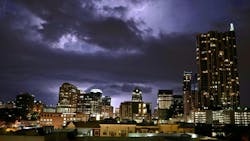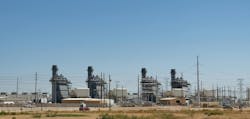Since the fatal effects of Winter Storm Uri struck Texas three years ago, two other major, named storms, hit the region and neither caused the power grid to fail the way it did in 2021.
It remains an open question how much Texas’ energy sector – famously deregulated and operating in some ways as an island unto itself – will fare during future winter storms, as well as summer heat waves and severe weather.
In January, Winter Storm Heather entered the U.S. in Oregon, caking Portland in ice before hopping the Rockies and sweeping through the South. Snow blanketed the area from Tulsa to Dallas and ice choked roads in Houston and San Antonio. There were some scattered, local outages, but the bulk power delivery system stayed on its feet, despite an even higher peak power surge than during Uri (78,138 MW during Heather versus 69,812 MW for Uri).
During Christmas 2022, Winter Storm Elliott caused outages for millions of Americans in the Eastern half of the country. According to a joint study into the storm’s impact by FERC and NERC, there were 3,565 unplanned outages in the Eastern Interconnection, largely resulting in 90,500 MW worth of power units that were offline unexpectedly. The commissions compared this impact to Uri’s impact on Texas, adding that this storm showed infrastructure east of the Mississippi is still vulnerable to extremely cold weather.
Texas was on the outside edge of Elliott’s impact, with the impact falling hardest on the South, Mid-South and Appalachian states. Both storms could be called glancing blows compared with Uri’s direct hit.
During Elliot, north of 80% of outages were the fault of temperatures being outside of historical data – whether the cause was a power plant shutting down, a natural gas wellhead freezing or some other temperature-related cause.
FERC Chairman Willie Phillips said the cause of wide-spanning, long-lasting outages, severe weather, is not going to go away.
“It shouldn’t take five winter storms in 11 years to show us the gravity of the situation we find ourselves in,” Phillips said in September 2023, adding that some recommendations from his commission’s 2021 Uri report are still not implemented.
We are now three years removed from at least 240 and perhaps as many as 700 lives lost and 10 million plus people losing power and there are still doubts on whether Texas can stand up to another large-scale event.
The main issue is being able to implement regulations and practices for events that are statistically low to happen – at least historically.
When the Electric Reliability Council of Texas, the operator for most of Texas’ power grid, instructed utilities to minimize power demand or risk more damage to the grid during the winter storm in February 2021, transmission companies were forced to cut off power to portions of the natural gas delivery system. Freezing wellheads and offline processing facilities made natural gas producers unable to supply adequate fuel to power plants, exacerbating the problem in a state where natural gas is the No. 1 source of electricity at more than 41%.
The new leadership at regulatory bodies is quick to point out that positive change has taken place. New weatherization regulations for energy facilities were adopted in May 2021. The Texas Public Utility Commission was tasked with creating and enforcing criteria for power plants, while the powerful Railroad Commission of Texas, which regulates oil and gas extraction, gas utilities, coal mining and other aspects of fuel and power production, set new requirements for natural gas facilities.
A raft of new state laws required officials and industry players to create a plan to ensure that important natural gas facilities continue to get power even if rolling blackouts were ordered. Other laws mandate winterization for power plants – a big item in FERC and NERC’s recommendations for Texas that went unheeded for years – and stiff fines for noncompliance from regulators.
ERCOT also implemented several management and grid operation modifications. They included requiring extra thermal power generation to be retained in reserve if power facilities went offline unexpectedly, or demand exceeded predictions.
Outages since Winter Storm Uri
Since the detriment to the grid in Feb. of 2021, there have been multiple cases of energy companies either issuing warnings for cold temperatures or requests to minimize the use of power in households.
During Elliot, Texas saw temperatures drop down to the low teens. Electricity demand skyrocketed, reaching levels close to that of the storm in 2021.
Despite these challenges, ERCOT did not have to reduce load during the cold snap since electricity generation and reserves were sufficient. Rolling blackouts were used by several other significant regional grids around the country due to a higher frequency of thermal plant failures brought on by cooler temperatures and precipitation.
A few other recently anticipated cold fronts forced ERCOT, the PUCT, and utilities like Austin Energy to release weather watches and to recommend lower electricity usage.
- Jan. 15, 2024 from PUCT
- Jan. 10, 2024 from ERCOT
- Dec. 4, 2023 from Austin Energy
- Aug. 24-30, 2023 from ERCOT
- June 20, 2023 from PUCT and ERCOT
Texas’ power grid is still vulnerable to extreme cold and heat as well as severe weather from thunderstorms to hurricanes. It’s safe to say alerts such as these, as well as the weather preparations that accompany them will be necessary in the future.
Leadership Changes
Investigations and controversies launched quickly after Uri, and many energy leaders changed roles in Texas. There continues to be turnaround in lead roles.
Texas S.B. 2154, signed by Abbot in 2021, increased the size of the PUCT board of commissioners from three to five after Uri, but as of press time only four commissioners are appointed, and none of the current commissioners have been on the job since before April 2021 (the three in charge during Uri were compelled to step down).
The new law also did away with the requirement that every PUCT commissioner must “be well informed and qualified in the field of public utilities and utility regulation,” but added requirements that they be Texas residents. Some of Texas’ energy regulators were criticized after Uri for living outside the state.
Commissioners Will McAdams and Peter Lake, appointed in April 2021, both stepped down in 2023 before their terms were up. PUCT commissioners serve six-year, staggered terms.
Around the time he resigned, Lake said the Texas power grid had been in crisis when he took over but was now more reliable than ever thanks to the PUCT and ERCOT’s reforms. Lake favored a plan of economic incentives to keep power plants in service and build new ones, but the state legislature preferred laws to pay direct bonuses for bringing new gas plants online and encouraging new plants through loans.
For his part, McAdams said he needed to spend more time with his family, adding the PUCT had a lot of new hires that should keep making progress on shoring up the power grid. In February 2024, he announced he’d be taking a lobbying position.
Thomas Gleeson was appointed chair of PUCT in January 2024. Gov. Greg Abbott, who picked Gleeson, pointed to his long record with the commission.
“Thomas Gleeson’s longtime service at PUCT and wealth of knowledge make him the ideal choice for Chair of the Commission,” Abbott said. “As a seasoned leader with over 15 years of experience at the agency, including serving as executive director and chief operating officer, Thomas will help ensure Texans and Texas communities have the utility services they need.”
Changes have also been in store at ERCOT. Jayapal Parakkuth was named the senior vice president and chief information officer. Venkat Tirupati was promoted to vice president, DevOps and Grid Transformation. Taylor taking on the role of senior vice president, chief financial officer and chief risk officer. Finally, Adam Martinez was given the role of vice president of Enterprise Risk and Strategy.
Anyone in a new job will need time to adjust to the learning curve, however the ERCOT leadership remains upbeat.
“Our responsibility to all Texans is to ensure we continue to maintain a reliable and resilient grid now and in the future. These organizational changes will support ERCOT’s continued mission to implement solutions for the challenges our industry faces and position us to meet this responsibility,” said ERCOT President Pablo Vegas, who took over in 2022.
Vegas’ predecessor, Brad Jones, died in November 2023 after serving as interim president and CEO at ERCOT from May 2021 to November 2022.
Vegas told a press conference before Winter Storm Heather that ERCOT performed hundreds of winterization checks through 2023. After the storm’s impact, the Texas power plant fleet saw roughly half the unit outages as during Uri. Also during the storm, Texas’ solar power sources provided nearly a fifth of generation at the peak of Heather’s impact, setting a record. The state’s powerful wind energy assets contributed up to 30% of power generation during Heather.
ERCOT is looking into another potential source of emergency power: the Pattern Energy Southern Spirit Transmission line, which has been under development for some 10 years – not an unusual span of time for these sorts of projects. In this proposal, Texas would be linked to an extra 3000 MW of power via about 320 miles of new transmission. The line will not be energized until at least 2029, and the states providing that power, Louisiana and Mississippi, have yet to approve the project. However, Southern Spirit would more than double the capacity of Texas’ present interconnections, according to project developers.
The ERCOT grid currently gets about 820 MW via the Southwest Power Pool and about 400 MW from a pair of lines linking it with the grid managed by Mexico’s Comisión Federal de Electricidad. The Texas Interconnection, managed by ERCOT, continues to operate separately from the Eastern and Western interconnections as a way of sidestepping oversight from federal organizations such as FERC.
Remaining Concerns
The Texas grid has gotten by the cold spells of the past, but they have yet to face anything close to the cold temperatures and outages seen back in 2021.
What's most concerning is, even though temperatures were about 10 degrees warmer, power demand during the most recent incident almost surpassed levels from Uri. The day before the cold front came, ERCOT's own demand estimate was off by 12,000 MW due to changing factors such as home heating electrification and population growth.
Grid reliability is becoming more and more dependent on an aging fleet of coal and gas facilities as energy demand rises. In periods of extreme heat or cold, these facilities are less effective at counteracting projected dips in intermittent power sources like wind or solar. Building new power plants is such an expensive prospect for companies that it is difficult to imagine a few incentives passed by the state legislature moving the needle much.
Regulators are assessing potential improvements to the electricity market. However, in the interim, until additional capacity is brought online under a better market structure, ERCOT will face difficulties in maintaining balances between supply and demand throughout extreme weather events due to the increasing discrepancy between the increasing renewable capacity and completely transportable resources.
The Lone Star State requires its utilities to cut down peak demand by 0.4%, a regulation unchanged since 2011, according to ACEEE. The state also lacks a demand response program that could compensate ratepayers for using less electricity at peak, which could help.
Local utilities and retail companies are doing what they can on a piecemeal basis with their own programs, but overall, it seems easier to save electricity than it would be to build a fleet of new power plants.
Troublingly, Texas has also become a haven for cryptocurrency miners, attracted by lax regulations and cheaper energy. Bitcoin miners eat up some 2100 MW in Texas, according to the Texas Blockchain Council, a trade group. The legislature reacted by putting tax breaks for miners on the chopping block.
ERCOT has said crypto miners applied to them to use as much as 20 GW, which is a staggering figure to consider when 7.5 GW is what ERCOT found itself needing to shed three years ago to prevent the complete collapse of the Texas grid.
Crypto traders point out that ERCOT can strike deals to pay miners to switch off their energy-hungry rigs when power supplies are tight, but the cost of that gets passed on to ordinary ratepayers. Texas consumers still remember getting stuck with record-high utility bills during Uri thanks to regulations intended to encourage energy production during times of high demand. Texas courts are still weighing the question of whether this should have been done at a time when millions of people were in a blackout. Wood Mackenzie and the New York Times estimated the demand from crypto mines have led to utility bills rising about $1.8 billion.
Texas remains an oddity in the power sector. Its mostly deregulated status combined with its vast capacity to produce its own energy and its pride in both has led to a several energy panics, including during Uri. We are mostly concerned with power grid stability here, and that is only achieved with long-term reliability. Three years is not long enough to determine whether we are there yet.
Some of Texas’ new regulations have teeth enough to be an improvement, but continued changes will be needed as temperature extremes continue to be the rule rather than the exception.
About the Author
Ryan Baker
Ryan Baker is a writer and associate editor with prior experiences in online and print production. Ryan is an associate editor for T&D World and Firehouse, while he is going to graduate school in pursuit of a master's degree in sciences of communication at University of Wisconsin-Whitewater. He recently completed a year of teaching Intro to Public Speaking at UW-Whitewater, as part of his graduate program. Ryan acquired his bachelor's degree in journalism in 2023 from UW-Whitewater, and operates currently out of Minneapolis, MN. Baker, also writes freelances for the Ultimate Frisbee Association (UFA) in his free time, while also umpiring baseball for various ages across the Twin Cities Metro Area.






